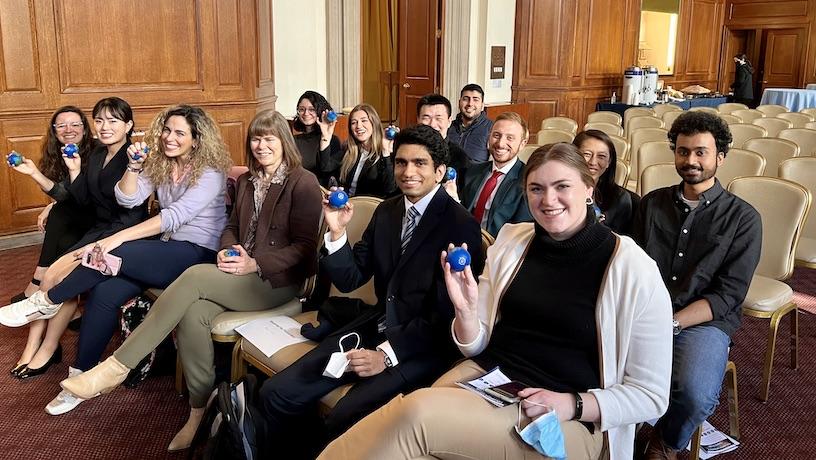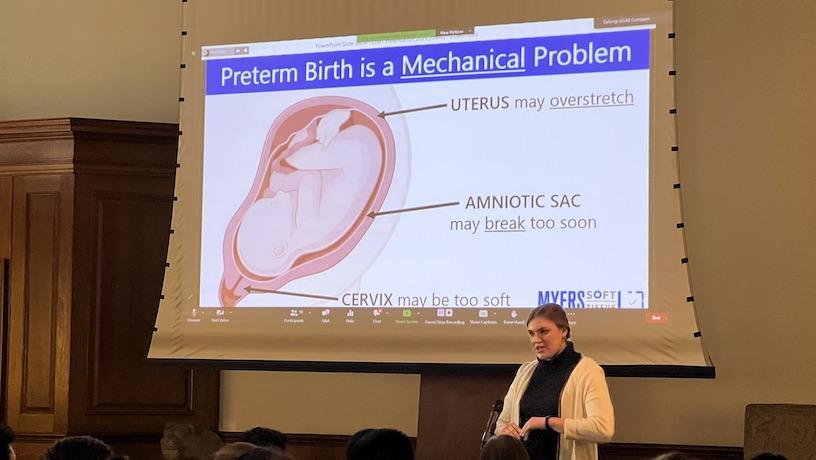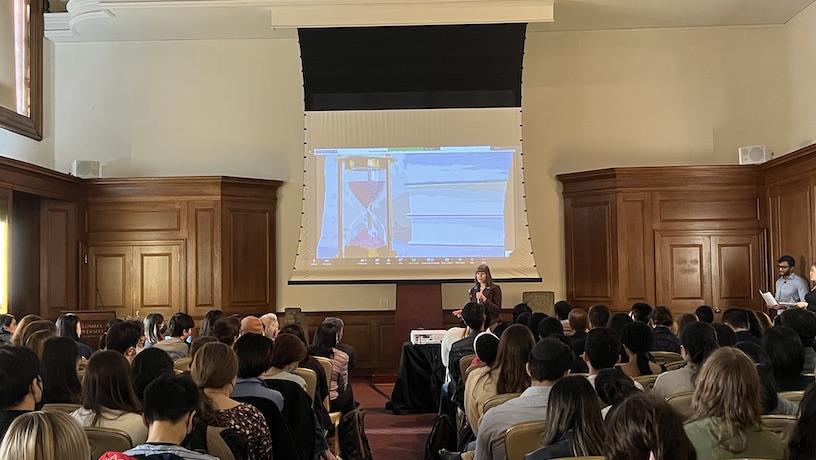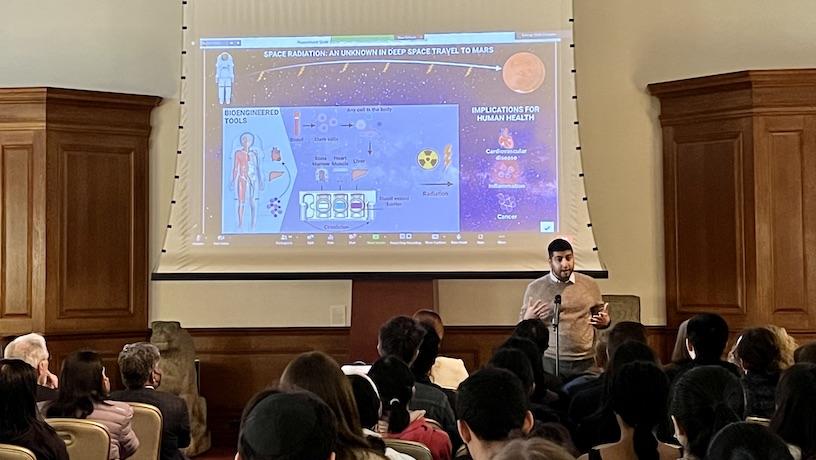Complex Research Conveyed in Just Three Minutes
Columbia’s annual Three Minute Thesis competition bridges the gap between academia and the general public, challenging students to present their research in under three minutes.

Participants of Columbia’s 2023 Three Minute Thesis Competition. Credit: Beatrice V. Mhando
Three Minute Thesis, also known as 3MT, is an annual competition held by 200 universities worldwide. Open to PhD students, the competition challenges students to compile all their years of research into a three minute presentation that can be understood to a general audience. This spring, Columbia University held its finals for the 3MT competition, in partnership with Columbia School of General Studies and Columbia Vagelos College of Physicians and Sugeons. With 13 finalists spanning the entire University, two students from Columbia Engineering won awards for their engaging presentations and insightful research.
Learn about the award-winning PhD students and their research
First Place: Erin Louwagie

Credit: Beatrice V. Mhando
Field: Mechanical Engineering
Advisor: Kristin Myers
Presentation Title: "A patient-specific computational approach to study mechanical causes for preterm birth"
Erin Louwagie's journey to Columbia's doctorate program began during her undergraduate studies at the University of Minnesota Twin Cities, relatively close to her hometown of Plymouth. Initially pursuing biomedical engineering, she quickly realized that she didn't have a stomach for medicine, stating she "absolutely fainted” on a BME tour. “So I switched to mechanical, because it's very broad and had less chemistry.”
However, Louwagie’s love for the human body persisted–studying biomedical research within mechanical engineering labs–which culminated in her initial meeting with Kristin Myers, associate professor of mechanical engineering at Columbia Engineering. Myers studies the biomechanics of maternal reproductive soft tissues, such as the cervix and uterus, to uncover the tissues’ mechanical function in pregnancy to develop safe interventions that prevent preterm birth.
"I saw Kristin present and I was like, ‘No one told me you can do mechanical engineering and women's health, that's so cool!’ So I applied to Columbia.”
The inspiration for Louwagie’s research stemmed from the biomechanical issues that can lead to preterm birth. During pregnancy, the body performs a multitude of new functions, a lot being mechanical in nature. Usually, people have uncomplicated pregnancies, but when things get complex, medical professionals don’t yet have a full grasp of the normal mechanics of pregnancy, making it hard to identify abnormalities.
Louwagie’s team focuses on noting the normal mechanics of the uterus, cervix, and fetal membranes, as while they change and grow, these mechanics provide integral support throughout the pregnancy. Figuring out these components can hopefully aid researchers in discovering the mechanical causes of preterm birth, something that medical professionals are still in the dark about. “What we're trying to do is establish what's normal in human populations by using clinical tools that are already being used in normal patient visits, and then seeing– what can we extract? Are there any small things that we can add to build this dataset? And then from that data set, we can simulate what happens in each mom's pregnancy,” Louwagie said. “Once we get to that step, we can start teasing out what's normal, what's abnormal, what would put someone at higher risk for preterm birth, and hopefully, better predict which patients will deliver preterm; and once we know they are at-risk, can we then give them personalized treatment to prevent their preterm birth?”
Louwagie’s research ultimately revealed the immense dearth in studies on women’s health, especially for expecting mothers. However, she stays hopeful for the next generation of biomechanical engineers to pave the way for improving research on female bodies. “There's actually been quite a lot of growth, even since I've started in terms of people who are wanting to investigate specifically women's health-related problems, not just in pregnancy,” she said.
“I’m glad that we’ve gotten to where we are, but there’s still a long way to go.”
Second Place: Cherie Henderson

Credit: Beatrice V. Mhando
Field: Communications
Presentation Title: "Living while dying: Terminal Illness Narratives and the Cultural Construction of the End of Life"
Cherie Hendersen is older than your average PhD student. After receiving her bachelor’s degree in journalism, she spent 17 years as an editor and writer at The Miami Herald and The Associated Press.
While at the AP, she was diagnosed with advanced cancer. She was 33.
"I burned out on journalism and started teaching writing classes at Memorial Sloan Kettering for people who had recently finished treatment,” Henderson said. "That led me to Columbia's narrative medicine master’s program, which I did from 2011 to 2014.”
A fairly new field, the narrative medicine program was started by Columbia medical professionals, creative writers, and humanities professors looking for ways to better understand the stories surrounding health from a clinical and literary perspective. "Since then, many people have applied the ideas in different ways,” Henderson said. "I have tended to think about it as a patient, probably in part because of my own experience having had cancer – how stories work from the patients' point of view.”
The inspiration for Henderson's research came to her while co-lecturing a class on death and dying. A video about a woman named Brittany Maynard was released by an organization that advocates for the ability of terminally ill patients to end their own lives, allowing them “death with dignity.”
In the video, Maynard tells how she moved to Oregon because she had deadly brain cancer and wanted to take advantage of laws that allowed her to take her own life with medical assistance. She argued for the state of California to pass a similar law.
That’s when Henderson had her “lightbulb moment” about the ways that stories of terminal illness differ from other stories of illness. “When people with curable illnesses tell their story, it’s usually about how it changed them as they went from before to after. And if you are terminally ill, there's no after,” Henderson said. “They tell a quite different story. I realized that a lot of the scholarship that's been done on illness stories doesn't always apply to the stories that people with terminal illnesses tell.”
Henderson’s Three Minute Thesis highlighted the differing perspectives of individuals that reveal our own cultural assumptions about illness, especially for people who are nearing the end of their lives. Henderson noted that individuals who are terminally ill can’t triumph over their illness, a la Lance Armstrong. But sometimes they discover what she calls an “alternative triumph,” where they find ways to make their remaining time meaningful.
“Analyzing these stories teaches us how people are living while dying, and that gives us cues that help us think through decisions about quality of life at the end of life,” Henderson said in her presentation.
“Truly hearing these stories helps us create a better ethic of caregiving. Truly hearing can lead to better dying for all of us.”
Audience Choice: Naveed Tavakol

Credit: Beatrice V. Mhando
Field: Biomedical Engineering
Advisor: Gordana Vunjak-Novakovic
Presentation Title: "Astronaut-on-a-chip: Bioengineered human tissues for studying cosmic radiation"
Naveed Tavakol’s journey to finding his research thesis started during his post-graduate fellowship in Switzerland. “The experience was really great for me to learn about different areas of stem cell biology that I wasn’t exposed to in undergrad, but were also very critical to my graduate degree,” he said. The experience eventually inspired his PhD research at Columbia.
Tavakol’s work focuses on engineering human tissue models of specific organs to model different diseases. This works by retrieving cells from the patient and making stem cells from that sample, ultimately being able to make and model any cell type in the body. “From a sample of your blood, we can make heart cells or liver cells or bone cells,” he said. “The goal is to make these models so that they can predict some of what you would see in different diseases if you're testing different drugs, but also in the context of deep space travel.”
Tavakol and the lab partnered with Translational Research Institute for Space Health (TRISH), A NASA-funded agency aiming to research and develop innovative approaches to reduce risks to humans on long-duration exploration missions. Tavakol’s team studied the health effects of exposure to radiation during long-term deep space missions, a crucial piece of knowledge for NASA’s future manned mission to Mars that is still not completely understood.
Engineering human tissue to simulate the effects of radiation is the most accurate and ethical form of replicating these celestial environments. The resulting effect is an imitation of the cosmic radiations that would be seen in a mission to Mars, but on a petri dish.
“The goal was basically to see if we can mimic what is going to happen to human tissues in these deep space missions,” Tavakol said. “And then from there, see if we can use these tools to predict what will happen and then develop drugs or protective measures to prevent any damaging effects if an astronaut were to actually travel to Mars”
During his presentation, Tavokol stressed the importance of the 3MT competition for creating a bridge between academia and the general public by transforming complex concepts into something that is accessible to all.
“When I tell my friends about the research I'm doing they're really interested in it and get excited,” Tavakol said. “I think it’s important to convey science in a way that is understandable to not just biologists and physicists in the engineering context but also the broader community. Being able to summarize my research in a very short amount of time is very difficult, but also a very nice way to wrap it up.”
